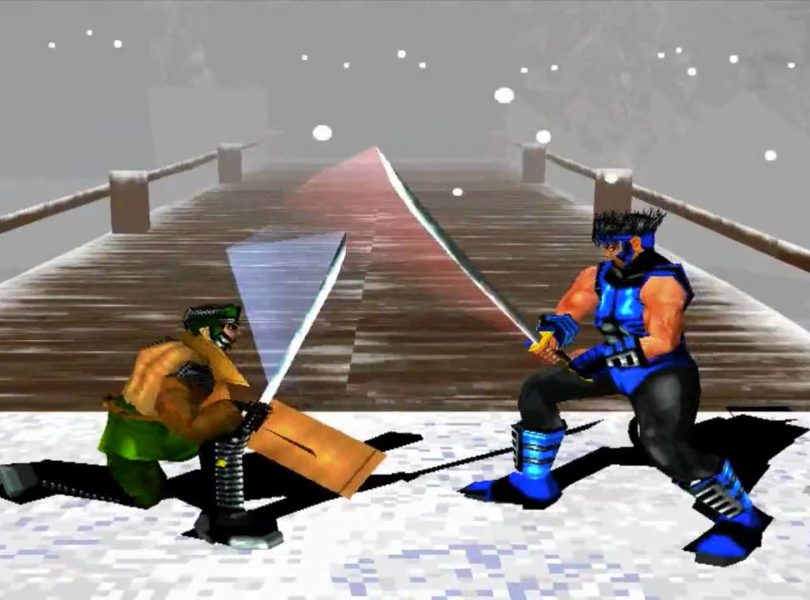Release Date: March 14, 1997
Developer: SquareSoft, Light Weight
Publisher: SquareSoft
With all the attention For Honor’s closed alpha received this past weekend, I felt it only appropriate to go back and look at Bushido Blade, the PS1 game that For Honor’s stance system reminded me of. So I fired up my PlayStation 2 top-loader, popped in my copy of the game in, and gave it a shot. Ten minutes later, I turned off my PS2 swearing like a sailor with gonorrhea.
The game is not bad. On the contrary, everything I remember about the gameplay and presentation are still evident, dulled only by the realities of time and technology. The game is just brutal in ways that would make a Mormon curse.
The game throws the player into modern (for 1997) Japan and allows them to choose from one of six noble samurai: Black Lotus, Hotarubi (Red Shadow), Kannuki, Mikado, Tatsumi, and Utsusemi. Each has his or her own backstory and their proficiency with at least one of eight selectable weapons – broadsword, katana, naginata, nodachi, rapier, saber, short sword, war hammer – but can equip any of them. During gameplay, your selected samurai can wield their weapon three different ways: high, middle, and low, and players can attack in three different ways from each stance. Needless to say, that’s a lot of variables for combat.
Those variables are evident in play. During combat, your chosen samurai feels sluggish when wielding a weapon he or she is not proficient with. Likewise, trying to strike your opponent from a low stance with the war hammer won’t be as effective as dropping the hammer from on high. Mixing and matching samurai, weapons, and stances was a great bit of tactical planning in the days before the proliferation of the internet and “best of” builds.
When fighting, other tactical advantages can be sought. Hitting an arm or leg can incapacitate an enemy, forcing them to fight hobbled or with their off-arm. Oddly, you can’t do both to an enemy, but just one of them can turn the tide in battle.
Then there’s the one other variable to take in when planning your killing spree in Bushido Blade: the Bushido code. This code requires that all combatants fight with honor. Striking an opponent in the back or when they’re down may secure a win, but it’s frowned upon. No, seriously, the game will stop your playthrough and CUSS YOU OUT for violating the Bushido code.
Did I mention that you can be killed in one hit? No? Well, you can be killed in one hit. No number of rounds, no slightly reducing life bar, just DEAD!
With all this, Bushido Blade is still a great game. The story mode, where the real meat of the game is, plays out like an old samurai movie. The settings are rich in detail for the time, the gameplay is fluid and at a constant 30 fps (early 3D games couldn’t hit 60 fps in consoles, period), and the soundtrack sets the mood perfectly. And you are not confined to standing around, waiting for an opponent. You can run through the countryside, over hills, across fields, and through mud and bodies of water. This is actually part of the strategy; players are able to rush through the terrain and seek an area they want to stand and fight in. You can also choose to do battle during the summer or winter, varying the elements accordingly. Running through snow and seeing the tracks you leave is commonplace now but a visual treat back then.
Sooner or later, though, that difficulty will creep up and smack you clear on the back of the head. There is no getting around it; this is a punishing game. The punishment is not cheap, however. Players have to strike the proper balance between character, weapon, stance, and situation in order to emerge victorious. For folks who love cerebral battles, this game will be endlessly pleasing.
Does it still hold up? Portions of it do. There is no denying that the combat is as pure and as heartless as it should be. The graphics, however, are weak even by 1997 standards. The PS1’s ability to crunch polygons was laudable but severely hampered by RAM constraints. The result, unfortunately, is not terribly nice on the eyes, especially now. It ain’t pretty, but for the swordplay purist, the actual combat is top-notch.
For those who wish to play it now, there is bad news. Bushido Blade was never re-released outside of Japan, not even as part of the PS1 Classics on PSN. Japan did get a re-release with their Ultimate Hits line, including the sequel, and both games in the equally awesome Tobal series. Outside of Japan, the only options are the two E’s: eBay or emulation. I won’t recommend the latter, but will say the former is not a terrible prospect, especially for owners of a compatible console. Regardless, the game is one that gamers should definitely check out. Just be prepared to apologize for the cursing.
Good: Tight, fluid gameplay; engaging combat; great presentation
Bad: Unforgiving difficulty; crude PS1-era graphics
Final score: 8/10


